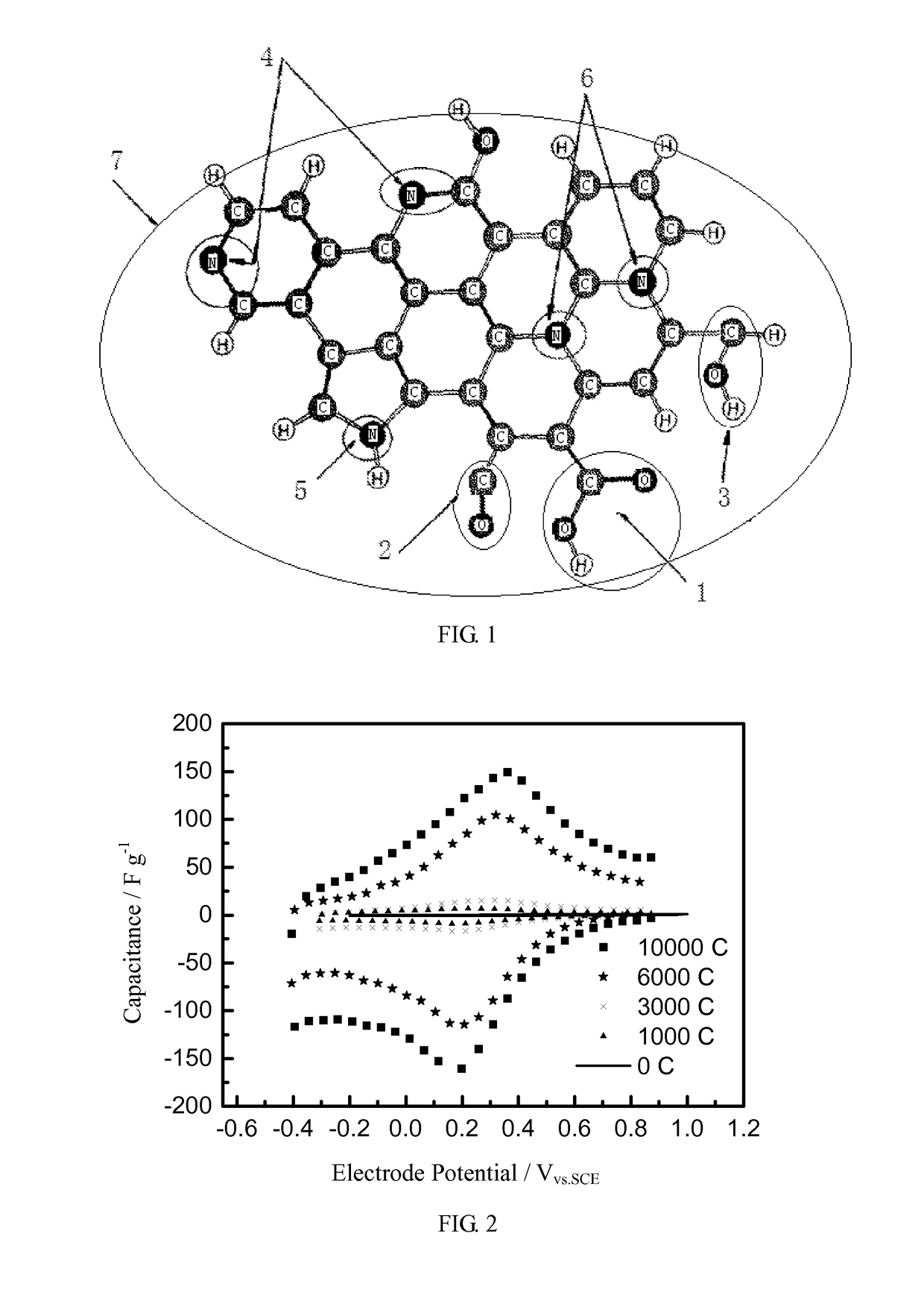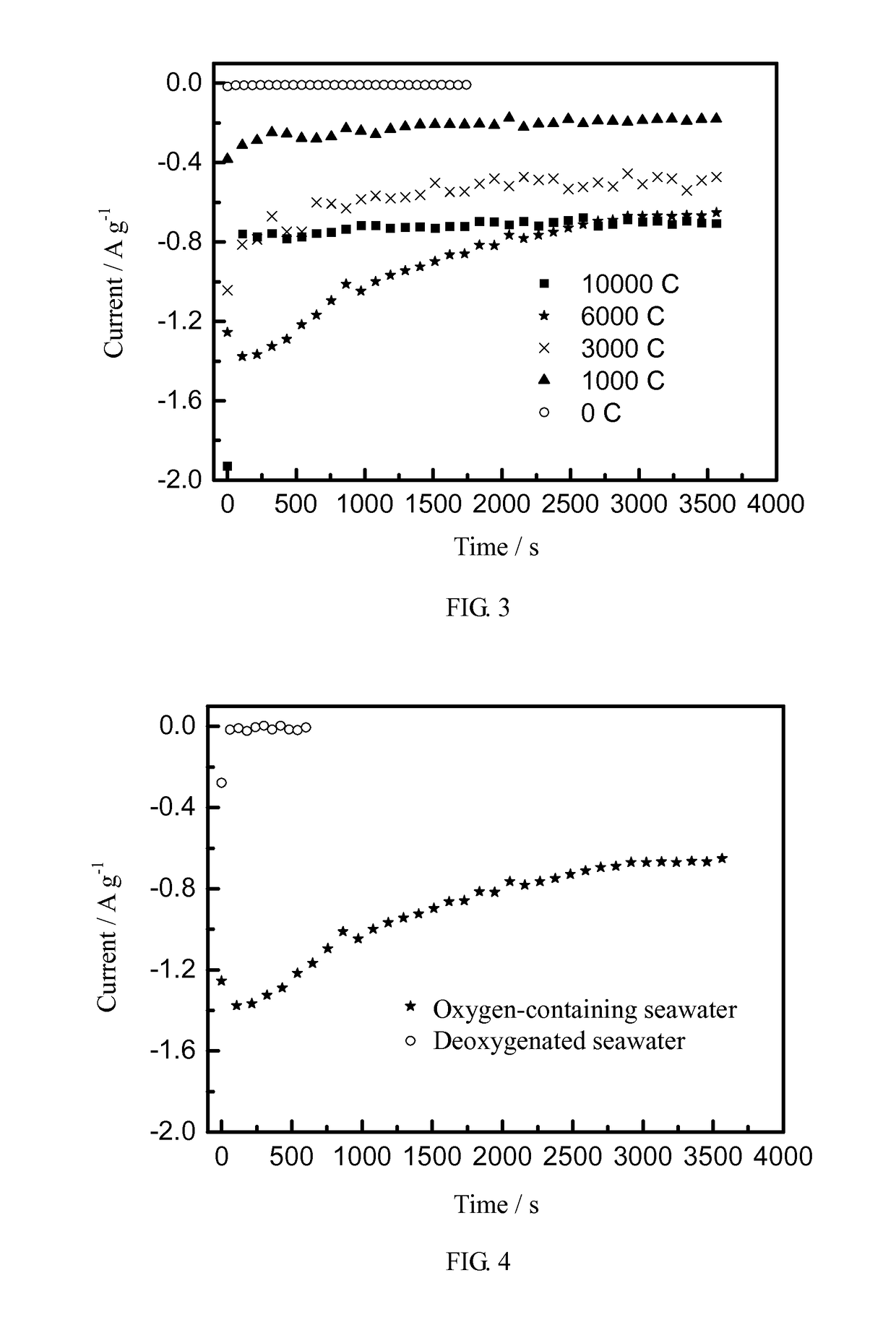Oxygen and nitrogen co-doped polyacrylonitrile-based carbon fiber and preparation method thereof
a technology of polyacrylonitrile and carbon fiber, which is applied in the direction of fuel and primary cells, deferred-action cells, cell components, etc., can solve the problems of poor impact resistance, metal carbonization, carburization and electrochemical corrosion when compounded with metals, and commercialization has been thwarted by two major technical limitations, so as to improve the activity and performance in use, good activity, and high conductivity
- Summary
- Abstract
- Description
- Claims
- Application Information
AI Technical Summary
Benefits of technology
Problems solved by technology
Method used
Image
Examples
example 1
[0046]This example provides a kind of oxygen and nitrogen co-doped PAN-based carbon fiber filaments, which were prepared by electrochemical modification of the T700SC 12K PAN-based carbon fiber filaments such that their surface had an active layer formed by oxygen-containing active functional groups and nitrogen-containing active functional groups, wherein the nitrogen-containing active functional groups were obtained after activation of the non-active doped nitrogen inherent in the unmodified raw-material PAN-based carbon fibers by the electrochemical modification.
[0047]The method for preparing the oxygen and nitrogen co-doped PAN-based carbon fiber filaments according to this example comprised the steps of:[0048]placing 1 g of T700SC 12K PAN-based carbon fiber filaments in a 0.5 M aqueous solution of sulfuric acid;[0049]subjecting the raw-material PAN-based carbon fiber filaments to electrochemical anodic oxidation for 5 min and then to electrochemical cathodic reduction for 5 min...
example 2
[0058]This example provides a kind of oxygen and nitrogen co-doped PAN-based carbon fiber felt, which was prepared by electrochemical modification of PAN-based carbon fiber felt (thickness: 6 mm; mass per geometric area: 0.1 g / cm2) such that its surface had an active layer formed by oxygen-containing active functional groups and nitrogen-containing active functional groups, wherein the nitrogen-containing active functional groups were obtained after activation of the non-active doped nitrogen inherent in the unmodified raw-material PAN-based carbon fibers by the electrochemical modification.
[0059]The method for preparing the oxygen and nitrogen co-doped PAN-based carbon fiber felt according to this example comprised the steps of:[0060]placing 0.1 g of the PAN-based carbon fiber felt in a 10 wt % aqueous solution of ammonium bicarbonate;[0061]subjecting the raw-material PAN-based carbon fiber felt to electrochemical anodic oxidation for 5 min and then to electrochemical cathodic redu...
example 3
[0063]This example provides a kind of oxygen and nitrogen co-doped PAN-based carbon fiber filaments, which were prepared by electrochemical modification of the T300 12K PAN-based carbon fiber filaments such that their surface had an active layer formed by oxygen-containing active functional groups and nitrogen-containing active functional groups, wherein the nitrogen-containing active functional groups were obtained after activation of the non-active doped nitrogen inherent in the unmodified raw-material PAN-based carbon fibers by the electrochemical modification. This example further provides a brush electrode made from the oxygen and nitrogen co-doped PAN-based carbon fiber filaments, which can be used for the waste water treatment technology by the Electro-Fenton method.
[0064]The method for preparing the oxygen and nitrogen co-doped PAN-based carbon fiber filaments and the brush electrode made thereof according to this example comprised the steps of:[0065]placing 2 g of T300 12K ...
PUM
| Property | Measurement | Unit |
|---|---|---|
| elongation | aaaaa | aaaaa |
| resistivity | aaaaa | aaaaa |
| temperature | aaaaa | aaaaa |
Abstract
Description
Claims
Application Information
 Login to View More
Login to View More - R&D
- Intellectual Property
- Life Sciences
- Materials
- Tech Scout
- Unparalleled Data Quality
- Higher Quality Content
- 60% Fewer Hallucinations
Browse by: Latest US Patents, China's latest patents, Technical Efficacy Thesaurus, Application Domain, Technology Topic, Popular Technical Reports.
© 2025 PatSnap. All rights reserved.Legal|Privacy policy|Modern Slavery Act Transparency Statement|Sitemap|About US| Contact US: help@patsnap.com



